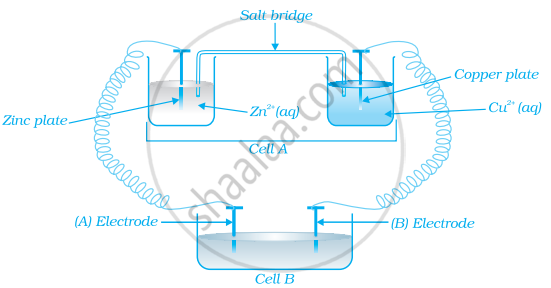Advertisements
Advertisements
Question
The standard e.m.f of the following cell is 0.463 V
`Cu|Cu_(1m)^(++)`
What is the standard potential of Cu electrode?
(A) 1.137 V
(B) 0.337 V
(C) 0.463 V
(D) - 0.463 V
Solution
(b) 0.337 V
APPEARS IN
RELATED QUESTIONS
Arrange the following reducing agents in the order of increasing strength under standard state conditions. Justify the answer
|
Element |
Al(s) |
Cu(s) |
Cl(aq) |
Ni(s) |
|
Eo |
-1.66V |
0.34V |
1.36V |
-0.26V |
Calculate Ecell and ΔG for the following at 28°C :
Mg(s) + Sn2+( 0.04M ) → Mg2+( 0.06M ) + Sn(s)
E°cell = 2.23V. Is the reaction spontaneous ?
Calculate emf of the following cell at 25°C:
\[\ce{Sn/Sn^2+ (0.001 M) || H+ (0.01 M) | H2_{(g)} (1 bar) | Pt_{(s)}}\]
Given: \[\ce{E^\circ(Sn^2+/sn) = -0.14 V, E^\circ H+/H2 = 0.00 V (log 10 = 1)}\]
Calculate e.m.f of the following cell at 298 K:
2Cr(s) + 3Fe2+ (0.1M) → 2Cr3+ (0.01M) + 3 Fe(s)
Given: E°(Cr3+ | Cr) = – 0.74 VE° (Fe2+ | Fe) = – 0.44 V
Calculate emf of the following cell at 25 °C :
Fe|Fe2+(0.001 M)| |H+(0.01 M)|H2(g) (1 bar)|Pt (s)
E°(Fe2+| Fe)= −0.44 V E°(H+ | H2) = 0.00 V
Calculate e.m.f. and ∆G for the following cell:
Mg (s) |Mg2+ (0.001M) || Cu2+ (0.0001M) | Cu (s)
`"Given :" E_((Mg^(2+)"/"Mg))^0=−2.37 V, E_((Cu^(2+)"/"Cu))^0=+0.34 V.`
Given the standard electrode potentials,
\[\ce{K+/K}\] = −2.93 V, \[\ce{Ag+/Ag}\] = 0.80 V,
\[\ce{Hg^{2+}/Hg}\] = 0.79 V
\[\ce{Mg^{2+}/Mg}\] = −2.37 V, \[\ce{Cr^{3+}/Cr}\] = −0.74 V
Arrange these metals in their increasing order of reducing power.
Depict the galvanic cell in which the reaction \[\ce{Zn(s) + 2Ag+(aq) → Zn^{2+}(aq) + 2Ag(s)}\] takes place. Further show:
- Which of the electrode is negatively charged?
- The carriers of the current in the cell.
- Individual reaction at each electrode.
In the representation of the galvanic cell, the ions in the same phase are separated by a _______.
Draw a neat and labelled diagram of the lead storage battery.
Calculate the emf of the following cell at 25°C :
Galvanic or a voltaic cell converts the chemical energy liberated during a redox reaction to ____________.
Standard hydrogen electrode operated under standard conditions of 1 atm H2 pressure, 298 K, and pH = 0 has a cell potential of ____________.
Which cell will measure standard electrode potential of copper electrode?
Using the data given below find out the strongest reducing agent.
`"E"_("Cr"_2"O"_7^(2-)//"Cr"^(3+))^⊖` = 1.33 V `"E"_("Cl"_2//"Cl"^-) = 1.36` V
`"E"_("MnO"_4^-//"Mn"^(2+))` = 1.51 V `"E"_("Cr"^(3+)//"Cr")` = - 0.74 V
Consider the figure and answer the following question.
If cell ‘A’ has ECell = 0.5V and cell ‘B’ has ECell = 1.1V then what will be the reactions at anode and cathode?
Represent the cell in which the following reaction takes place.The value of E˚ for the cell is 1.260 V. What is the value of Ecell?
\[\ce{2Al (s) + 3Cd^{2+} (0.1M) -> 3Cd (s) + 2Al^{3+} (0.01M)}\]
Which is the correct order of second ionization potential of C, N, O and F in the following?
The potential of a hydrogen electrode at PH = 10 is
Standard reduction potentials (E°) of Cd2+, respectively which is the strongest reducing agent
The emf of a galvanic cell, with electrode potential of Zn2+ = - 0.76 V and that of Cu2+ = 0.34 V, is ______.
